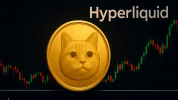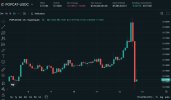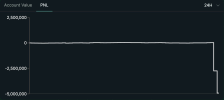- BHT
- 7
 89
89
 0
0
I'll never forget November 12th, 2025. That was the day I watched in real-time as sophisticated market manipulation unfolded before my eyes on Hyperliquid, leaving traders like myself questioning everything we thought we knew about decentralized exchanges.

It started innocently enough. I noticed unusual activity on POPCAT token-someone was building a massive long position. What caught my attention wasn't just the size, but the audacity: A $20 million buy wall sitting confidently at $0.21. My heart raced with excitement. "This must be institutional money," I thought, like so many others watching those green candles climb.

The whale had withdrawn $3 million USDC from OKX and split it across 19 different wallets, creating leveraged positions worth between $20-30 million. The buy wall looked solid, immovable-a fortress of demand that screamed "accumulation phase." Traders rushed in, opening long positions, convinced they'd found the next moonshot.
I remember feeling that familiar FOMO creeping in. The kind that makes your palms sweaty and your finger hover over the buy button.
Then, in seconds, everything changed.
The whale ripped away the buy wall like pulling a tablecloth from under a dinner set-except everything crashed to the floor. POPCAT plummeted 43% in a flash, dropping from $0.21 to $0.12. My screen turned red. Not just my positions, but hundreds of others.

The liquidations came like dominoes falling-$63 million worth of long positions vaporized in moments. The attacker's own $3 million collateral? Gone instantly. But that was the point. This wasn't incompetence; this was weaponized market manipulation.
Hyperliquid's HLP (Hyperliquidity Provider) system, designed to absorb positions during liquidations, became the ultimate victim-swallowing a $4.9 million loss in bad debt. Watching it unfold felt like witnessing a meticulously planned heist where the thief burns their own getaway car just to ensure the bank vault explodes.
My stomach sank further when I realized this was Hyperliquid's third major manipulation incident in 2025.
In March, the platform faced the infamous JELLY token attack, where a whale manipulated the price of the JELLYJELLY meme coin, leaving HLP with nearly a $12 million unrealized loss. The attacker bought JELLY externally, pumped the price on-chain, and forced their short position into liquidation-sticking Hyperliquid with the tab. Validators had to freeze and delist the token, settling contracts at arbitrary prices to salvage a $700, 000 gain instead of a catastrophic loss.
Then there was the XPL pre-market contract incident in August, where whales orchestrated a 200% price surge in minutes, liquidating shorts and pocketing $38 million in profits. The platform's limited liquidity on pre-market contracts created the perfect hunting ground for coordinated attacks.
Each attack exposed the same vulnerabilities: Thin liquidity, automated liquidation absorption, and inadequate safeguards against concentrated manipulation.
As someone who believed in decentralized finance's promise, watching these attacks felt personal. I'd championed Hyperliquid to friends, praised its innovation, defended its model. Now I felt foolish.

The crypto community erupted with conspiracy theories-some accused Binance and OKX of coordinating attacks to destroy a DEX competitor, especially since both exchanges listed JELLY perpetuals during the chaos. Whether true or not, the paranoia itself revealed how fragile trust had become.
One trader on X captured it perfectly: "Peak degen warfare. Someone torched $3M just to nuke liquidity and drag HLP into a $5M loss". That's exactly how it felt-like financial warfare where retail traders were collateral damage.
This experience taught me brutal lessons about risk management in crypto trading. No buy wall is safe. No position is immune. And decentralized doesn't always mean secure.
The platforms claiming to be decentralized sometimes exercise centralized control when convenient-Hyperliquid's validators manually closing positions and delisting tokens proved that. While this intervention prevented worse losses, it contradicted the decentralization narrative many of us had bought into.
Market manipulation isn't new, but the sophistication here was chilling. The attacker willingly sacrificed $3 million to inflict $4.9 million in damage-a calculated attack that felt more like a stress test or deliberate destabilization attempt than a profit-driven trade.
After this experience, I've fundamentally changed how I approach crypto trading. I no longer chase buy walls or assume large positions signal safety. I've learned that thin liquidity is a weapon, not just a inconvenience.
But I haven't given up on crypto-I've just gotten smarter about it.
If there's one thing these Hyperliquid incidents taught me, it's that going it alone in crypto is dangerous. The whales have sophisticated strategies, coordinated attacks, and millions to burn. Retail traders need every advantage we can get.
That's why I've turned to Binance Copy Trading. Instead of trying to outsmart market manipulators myself, I now follow experienced traders who've proven their strategies across multiple market conditions. Check out successful traders here
And if you're new to Binance, you can get started with a 100 USDT bonus when you register here
The crypto market will always have risks-that's unchangeable. But you can choose whether to face those risks alone or learn from traders who've survived events like the Hyperliquid attacks. I made my choice. What's yours?

The Setup That Fooled Everyone
It started innocently enough. I noticed unusual activity on POPCAT token-someone was building a massive long position. What caught my attention wasn't just the size, but the audacity: A $20 million buy wall sitting confidently at $0.21. My heart raced with excitement. "This must be institutional money," I thought, like so many others watching those green candles climb.

The whale had withdrawn $3 million USDC from OKX and split it across 19 different wallets, creating leveraged positions worth between $20-30 million. The buy wall looked solid, immovable-a fortress of demand that screamed "accumulation phase." Traders rushed in, opening long positions, convinced they'd found the next moonshot.
I remember feeling that familiar FOMO creeping in. The kind that makes your palms sweaty and your finger hover over the buy button.
The Collapse
Then, in seconds, everything changed.
The whale ripped away the buy wall like pulling a tablecloth from under a dinner set-except everything crashed to the floor. POPCAT plummeted 43% in a flash, dropping from $0.21 to $0.12. My screen turned red. Not just my positions, but hundreds of others.

The liquidations came like dominoes falling-$63 million worth of long positions vaporized in moments. The attacker's own $3 million collateral? Gone instantly. But that was the point. This wasn't incompetence; this was weaponized market manipulation.
Hyperliquid's HLP (Hyperliquidity Provider) system, designed to absorb positions during liquidations, became the ultimate victim-swallowing a $4.9 million loss in bad debt. Watching it unfold felt like witnessing a meticulously planned heist where the thief burns their own getaway car just to ensure the bank vault explodes.
This Wasn't the First Time
My stomach sank further when I realized this was Hyperliquid's third major manipulation incident in 2025.
In March, the platform faced the infamous JELLY token attack, where a whale manipulated the price of the JELLYJELLY meme coin, leaving HLP with nearly a $12 million unrealized loss. The attacker bought JELLY externally, pumped the price on-chain, and forced their short position into liquidation-sticking Hyperliquid with the tab. Validators had to freeze and delist the token, settling contracts at arbitrary prices to salvage a $700, 000 gain instead of a catastrophic loss.
Then there was the XPL pre-market contract incident in August, where whales orchestrated a 200% price surge in minutes, liquidating shorts and pocketing $38 million in profits. The platform's limited liquidity on pre-market contracts created the perfect hunting ground for coordinated attacks.
Each attack exposed the same vulnerabilities: Thin liquidity, automated liquidation absorption, and inadequate safeguards against concentrated manipulation.
The Emotional Toll
As someone who believed in decentralized finance's promise, watching these attacks felt personal. I'd championed Hyperliquid to friends, praised its innovation, defended its model. Now I felt foolish.

The crypto community erupted with conspiracy theories-some accused Binance and OKX of coordinating attacks to destroy a DEX competitor, especially since both exchanges listed JELLY perpetuals during the chaos. Whether true or not, the paranoia itself revealed how fragile trust had become.
One trader on X captured it perfectly: "Peak degen warfare. Someone torched $3M just to nuke liquidity and drag HLP into a $5M loss". That's exactly how it felt-like financial warfare where retail traders were collateral damage.
Lessons Burned Into Memory
This experience taught me brutal lessons about risk management in crypto trading. No buy wall is safe. No position is immune. And decentralized doesn't always mean secure.
The platforms claiming to be decentralized sometimes exercise centralized control when convenient-Hyperliquid's validators manually closing positions and delisting tokens proved that. While this intervention prevented worse losses, it contradicted the decentralization narrative many of us had bought into.
Market manipulation isn't new, but the sophistication here was chilling. The attacker willingly sacrificed $3 million to inflict $4.9 million in damage-a calculated attack that felt more like a stress test or deliberate destabilization attempt than a profit-driven trade.
Moving Forward Smarter
After this experience, I've fundamentally changed how I approach crypto trading. I no longer chase buy walls or assume large positions signal safety. I've learned that thin liquidity is a weapon, not just a inconvenience.
But I haven't given up on crypto-I've just gotten smarter about it.
Trade Smarter, Not Harder
If there's one thing these Hyperliquid incidents taught me, it's that going it alone in crypto is dangerous. The whales have sophisticated strategies, coordinated attacks, and millions to burn. Retail traders need every advantage we can get.
That's why I've turned to Binance Copy Trading. Instead of trying to outsmart market manipulators myself, I now follow experienced traders who've proven their strategies across multiple market conditions. Check out successful traders here
And if you're new to Binance, you can get started with a 100 USDT bonus when you register here
The crypto market will always have risks-that's unchangeable. But you can choose whether to face those risks alone or learn from traders who've survived events like the Hyperliquid attacks. I made my choice. What's yours?







